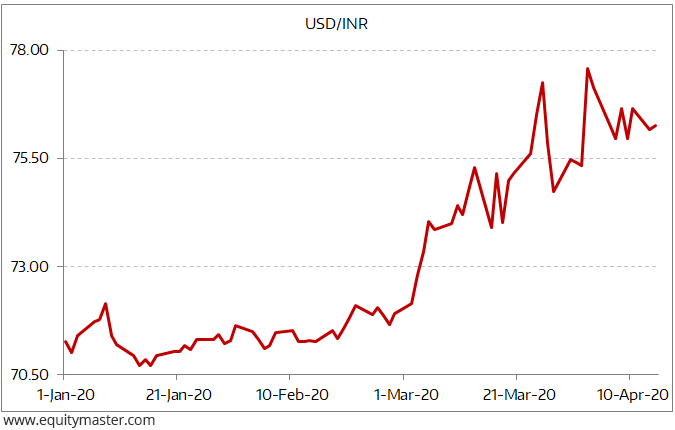India's Third Giant Leap
This Could be One of the Biggest Opportunities for Investors
- Home
- Todays Market
- Indian Stock Market News April 24, 2020
Sensex Opens Over 480 Points Down; Banking and Finance Stocks Fall Fri, 24 Apr 09:30 am
Asian stock markets are lower today as Chinese and Hong Kong shares fall. The Shanghai Composite is off 0.5% while the Hang Seng is down 0.3%. The Nikkei 225 is trading down by 0.8%. The S&P 500 ended marginally lower on Thursday after a report that an experimental antiviral drug for the coronavirus flopped in its first randomized clinical trial, denting optimism that the pandemic's impact on the labor market was nearing an end.
Back home, India share markets open lower. The BSE Sensex is trading down by 481 points while the NSE Nifty is trading down by 116 points. The BSE Mid Cap index and BSE Small Cap index opened down by 1.3% and 0.4% respectively.
Except capital goods stocks and healthcare stocks, all sectoral indices are trading in red with bank stocks and realty stocks witnessing maximum selling pressure.
Moving on, gold prices are currently trading up by 0.6% at Rs 46,427.
The rupee is currently trading at 76.10 against the US$.
The Indian rupee rose sharply against the US dollar yesterday as the risk sentiment improved in global markets.
Opening at 76.30 per dollar, the rupee further strengthened to 76.08 a dollar.
In comparison, the rupee had closed at 76.66 per US$ in the previous session after pulling back from record lows of 76.91 per US$.
On a year-to-date (YTD) basis, the rupee has depreciated sharply against the US dollar. While it started the calendar year 2020 at 71.28 against the US dollar, it is currently trading at 76.42 against the US dollar.
YTD Performance of the USD/INR

In a recent article titled The Sharp Fall in Indian Rupee: 6 Points to Know, we dive deeper and look at the factors behind rupee's depreciation.
We also reached out to Vijay Bhambwani, editor of Weekly Cash Alerts, who is closely tracking the Indian rupee in the current scenario. Here's what he has to say...
- The onset of Corona virus has not been kind to the INR.
The Rupee futures (USDINR) opened in March at 72.36 and have closed at 76.61 on April 09 2020. That is a decline of 5.87% in 6 short weeks.
The implications of the same will be widespread. India is a net importing Country. Everything that we import will now be more expensive. Approximately two thirds of all our imports are fossil fuels. Fuels are what we call multiplier effect commodities. If fuel prices rise at the petrol pumps, everything from fruits, vegetables, grains to dairy and poultry products get expensive.
That impact will be felt at a later date. I expect the trickle down effect to start appearing in prices after the April-June quarter is over.
I have already factored in this aspect in my statistical data model and plan to identify such events to generate profitable trading opportunities for my WCA plan subscribers.
Vijay has also talked about the Indian currency in a special edition podcast from Investor Hour. He shares what's around the corner for Indian rupee and how should position oneself for potential gains.
You can listen the entire episode here...

Moving on the news from economy. As per the Confederation of Indian Industry (CII), India's gross domestic product (GDP) will like shrink by 0.9% in the current financial year in a worst-case scenario marked by a prolonged coronavirus crisis that results in an extension of restrictions placed in Covid-19 hotspots, and may grow by as much as 1.5% in a best-case framework.
In a baseline scenario in which economic activity remains constrained and restrictions stay in place on the free movement of goods and people beyond the lockdown ending May 3, the economy could expand by just 0.6%.
India's economy, Asia's third largest, had already been slowing because of a downturn in household consumption and private sector investment when the coronavirus pandemic and the subsequent 40-day lockdown hit, causing a downgrade of most growth forecasts as industrial production came to a halt and public revenue declined.
The International Monetary Fund (IMF) has now forecast 1.9% growth for India in this fiscal, the slowest pace since 1991.
CII envisaged an extension of restrictions clamped on Covid-19 clusters and the addition of new hotspots in the worst-case scenario, which would entail stop-and-start economic activity in the optimistic scenario, it foresaw a faster pick-up after the lockdown.
CII called for urgent fiscal interventions to boost the sagging economy. It proposed cash transfers amounting to Rs 2 trillion to JAM (Jan Dhan, Aadhaar and mobile) account holders in addition to the Rs 1.7 lakh in relief measures the government has already announced.
To know what's moving the Indian stock markets today, check out the most recent share market updates here.
For information on how to pick stocks that have the potential to deliver big returns, download our special report now!
Read the latest Market Commentary


Equitymaster requests your view! Post a comment on "Sensex Opens Over 480 Points Down; Banking and Finance Stocks Fall". Click here!
Comments are moderated by Equitymaster, in accordance with the Terms of Use, and may not appear
on this article until they have been reviewed and deemed appropriate for posting.
In the meantime, you may want to share this article with your friends!